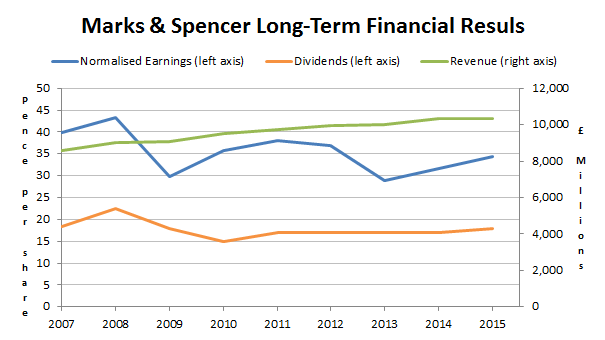Marks and Spencer is currently focused on international expansion and transforming itself into a true multi-channel retailer, but will that drive enough growth to offset its relatively weak dividend yield?
It’s an interesting question because, after looking at the company’s history, I think it would take a giant leap of faith to assume it can produce any kind of sustainable growth.
A low dividend yield means investors must be expecting market beating dividend growth
With Marks and Spencer’s shares currently trading at 565p, the company’s dividend yield is just 3.2%. That’s slightly below the 3.6% yield which is available from the FTSE 100 (with the large-cap index at 6,800 points).
To justify that lower dividend yield, investors must be expecting Marks and Spencer’s dividend to grow faster than “average”, i.e. faster than the FTSE 100’s dividend.
Over the long-term, the UK stock market has grown its dividend at around 2% after inflation, or a nominal 4% per year if we assume the Bank of England maintains inflation at 2%.
If the market keeps up that rate of growth then Marks and Spencer will have to grow its dividend faster than 4% a year, for many years, in order to justify its current low dividend yield.
To me it doesn’t look as if that’s the most likely outcome.
Marks and Spencer is not a high growth company
The chart below shows just how flat results have been at Marks and Spencer in recent years.

Revenues have been climbing, but the per-share earnings and dividend figures have gone less than nowhere.
And it doesn’t look any better if I convert that chart into numbers:
- 10-Yr Growth Rate of minus 0.8% – Which is negative (obviously) and below the very weak 1% earnings and dividend growth rate achieved by the FTSE 100 over the same period
- 10-Yr Growth Quality (i.e. consistency) of 67% – Slightly better than the very inconsistent 54% achieved by the FTSE 100
Although Marks and Spencer has produced a profitable dividend in every year, its results are nothing to shout about.
Of course, it does have various strategies to drive growth, such as international expansion, its transformation into a true multi-channel retailer (combining online and offline shopping channels), investing for efficiency and so on.
But its competitors all have their own strategies for growth, and while Marks and Spencer could turn things around and start producing…




